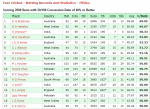it strikes me that whenever this topic comes out, the actual thing that needs to be discussed never is, and that is: would Bradman be able to repeat in the modern era his absolutely insane conversion rate. like, that's really needs to be discussed. you can talk about conditions, team strength and all that nonsense but the reality is: Bradman averaged 99 because once he got in, he did not get out. we (mostly) all understand that with the great batters, once they get in, they make you pay. Bradman just basically did that at a level no-one can compete with. he failed (scored under 20 runs in an innings) at ratios not really any different to any of the other great batters while at the same time keeping an insane conversion rate.
17 players have 4000 runs and a 50/100 conversion rate above 50% (to say nothing of double tons.) the only one close to him is Headley, who over a much longer FC career reverted back to below 50% (Bradman's stays well above 50% for his FC career) so I think it's probably fair to assume Headley's rate would have regressed a bit in a 52 test career (although I haven't checked to see if Headley's FC conversion rate tanked at the end of his career, like ricky ponting's conversion rate at the end of his test career. maybe he kept it at 65% for a long time).
and honestly, you look at those 17 players and only a couple of them are actually in the discussions for ATG line-ups. many of them I think are respected for what they could do to you, but are a step behind the actual greats of their era (Walcott being the obvious exception). bradman has the consistency of avoiding failing at the crease like the other greats (Sobers, Tendulkar, etc) while having a conversion rate that no-one can get close to.
and I don't really think there's any reason to believe his conversion rate would tank if placed in this era. so yeah I'd expect him to stay in that 90 to 100 neighbourhood.
Test Cricket - Batsmen with highest 50 to 100 conversion rate
howstat.com
View attachment 37131



